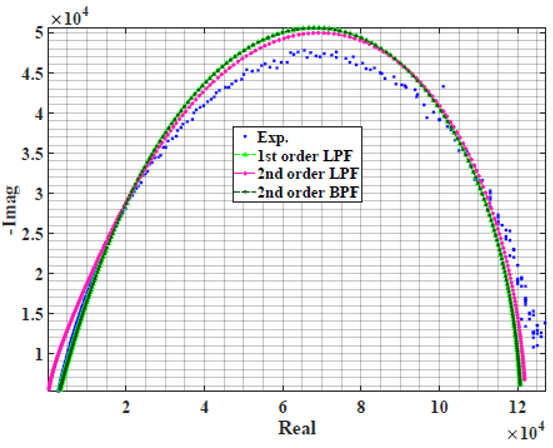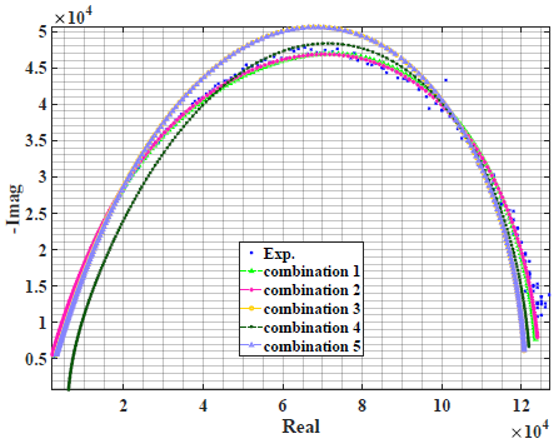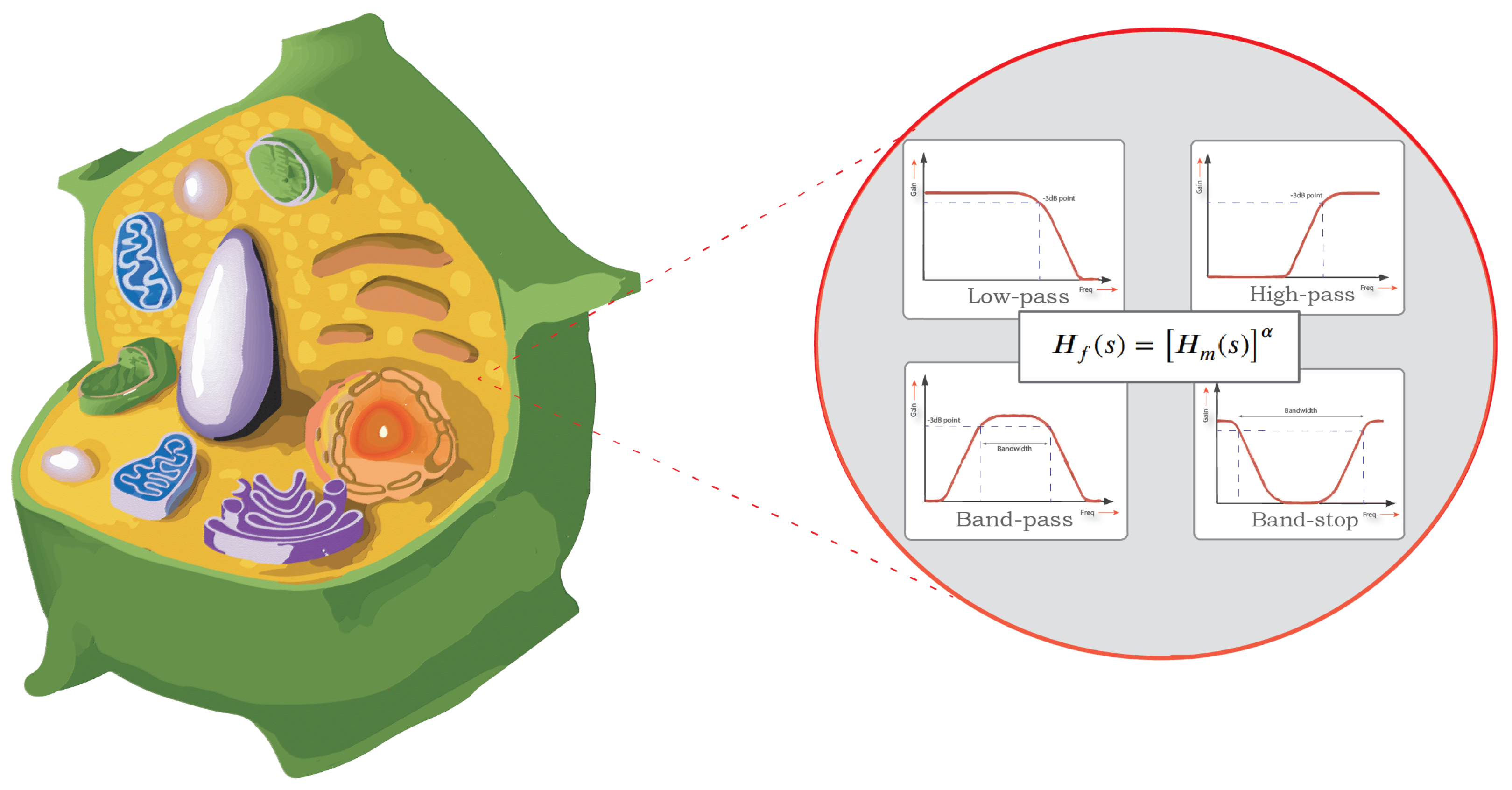Plant Tissue Modelling Using Power-Law Filters
Abstract
:1. Introduction
2. Power-Law Filters
2.1. Filters Based on First-Order Mother Functions
2.2. Filters Based on Second-Order Mother Functions
2.3. Power-Law Filter Sections
3. Problem Definition
- The objective function () used by the optimization algorithm is the minimization of the sum of the absolute error between the estimated impedance from the power-law filter and the measured one for each point in the frequency range represented as:where x is the vector of the optimized variables, model parameters of each filter type depending on the problem size, is the power-law filter impedance, is the actual-measured impedance of the sample, while n is the total number of the measured points.
- The number of iterations used in the optimization is 2500 iterations with 60 search agents and 50 independent runs through all the tested samples.
- The search agents search for the best solution in a range defined between a lower (LB) and an upper (UB) boundary defined differently for each filter order. For first-order filters, LB = [, K, ] = [0, 0, 0] and UB = [1, 1, 1], while for second-order filters LB = [, K, , Q] = [0, 0, 0, 0] and UB = [1, 1, 1 , 10].
4. Results and Discussion
4.1. Models Based on Single Power-Law Filters
4.2. Models Based on Power-Law Filters Sections
| Nyquist | Error | |
|---|---|---|
| Apple |  |  |
| Cucumber |  |  |
| Eggplant |  |  |
| Kiwi |  |  |
| Peach |  |  |
| Pear |  |  |
| Plum |  |  |
| Tomato |  |  |
| Nyquist | Error | |
|---|---|---|
| Apple |  |  |
| Cucumber |  |  |
| Eggplant |  |  |
| Kiwi |  |  |
| Peach |  |  |
| Pear |  |  |
| Plum |  |  |
| Tomato |  |  |
5. Conclusions
Author Contributions
Funding
Acknowledgments
Conflicts of Interest
References
- Zhang, M.; Stout, D.; Willison, J. Electrical impedance analysis in plant tissues3. J. Exp. Bot. 1990, 41, 371–380. [Google Scholar] [CrossRef]
- Ghoneim, M.S.; Mohammaden, A.A.; Mohsen, M.; Said, L.A.; Radwan, A.G. A modified differentiator circuit for extracting Cole-impedance model parameters using meta-heuristic optimization algorithms. Arab. J. Sci. Eng. 2021, 46, 9945–9951. [Google Scholar] [CrossRef]
- Mohsen, M.; Said, L.A.; Madian, A.H.; Radwan, A.G.; Elwakil, A.S. Fractional-order bio-impedance modelling for interdisciplinary applications: A review. IEEE Access 2021, 9, 33158–33168. [Google Scholar] [CrossRef]
- Zhang, M.; Willison, J. Electrical impedance analysis in plant tissues11. J. Exp. Bot. 1991, 42, 1465–1475. [Google Scholar] [CrossRef]
- Li, J.; Xu, Y.; Zhu, W.; Wei, X.; Sun, H. Maturity assessment of tomato fruit based on electrical impedance spectroscopy. Int. J. Agric. Biol. Eng. 2019, 12, 154–161. [Google Scholar] [CrossRef]
- Fan, L.F.; Chai, Z.Q.; Zhao, P.F.; Tian, Z.F.; Wen, S.Q.; Li, S.M.; Wang, Z.Y.; Huang, L. Nondestructive measurement of husk-covered corn kernel layer dynamic moisture content in the field. Comput. Electron. Agric. 2021, 182, 106034. [Google Scholar] [CrossRef]
- Harker, F.R.; Forbes, S.K. Ripening and development of chilling injury in persimmon fruit: An electrical impedance study. N. Z. J. Crop Hortic. Sci. 1997, 25, 149–157. [Google Scholar] [CrossRef] [Green Version]
- Ibba, P.; Tronstad, C.; Moscetti, R.; Mimmo, T.; Cantarella, G.; Petti, L.; Martinsen, Ø.G.; Cesco, S.; Lugli, P. Supervised binary classification methods for strawberry ripeness discrimination from bioimpedance data. Sci. Rep. 2021, 11, 11202. [Google Scholar] [CrossRef]
- Jackson, P.J.; Harker, F.R. Apple bruise detection by electrical impedance measurement. HortScience 2000, 35, 104–107. [Google Scholar] [CrossRef] [Green Version]
- Cole, K.S. Permeability and impermeability of cell membranes for ions. In Cold Spring Harbor Symposia on Quantitative Biology; Cold Spring Harbor Laboratory Press: Cold Spring Harbor, NY, USA, 1940; Volume 8, pp. 110–122. [Google Scholar]
- Yousri, D.; AbdelAty, A.M.; Said, L.A.; AboBakr, A.; Radwan, A.G. Biological inspired optimization algorithms for cole-impedance parameters identification. AEU-Int. J. Electron. Commun. 2017, 78, 79–89. [Google Scholar] [CrossRef]
- Hayden, R.; Moyse, C.; Calder, F.; Crawford, D.; Fensom, D. Electrical impedance studies on potato and alfalfa tissue. J. Exp. Bot. 1969, 20, 177–200. [Google Scholar] [CrossRef]
- AboBakr, A.; Said, L.A.; Madian, A.H.; Elwakil, A.S.; Radwan, A.G. Experimental comparison of integer/fractional-order electrical models of plant. AEU-Int. J. Electron. Commun. 2017, 80, 1–9. [Google Scholar] [CrossRef]
- Freeborn, T.J.; Maundy, B.; Elwakil, A.S. Extracting the parameters of the double-dispersion Cole bioimpedance model from magnitude response measurements. Med. Biol. Eng. Comput. 2014, 52, 749–758. [Google Scholar] [CrossRef] [PubMed]
- Ghoneim, M.S.; Gadallah, S.I.; Said, L.A.; Eltawil, A.M.; Radwan, A.G.; Madian, A.H. Plant stem tissue modelling and parameter identification using metaheuristic optimization algorithms. Sci. Rep. 2022, 12, 3992. [Google Scholar] [CrossRef]
- Aboalnaga, B.M.; Said, L.A.; Madian, A.H.; Elwakil, A.S.; Radwan, A.G. Cole Bio-Impedance Model Variations in Daucus Carota Sativus Under Heating and Freezing Conditions. IEEE Access 2019, 7, 113254–113263. [Google Scholar] [CrossRef]
- Juansah, J.; Budiastra, I.W.; Dahlan, K.; Seminar, K.B. Electrical behaviour of garut citrus fruits during ripening changes in resistance and capacitance models of internal fruits. IJET-IJENS 2012, 12, 1–8. [Google Scholar]
- Islam, M.; Wahid, K.A.; Dinh, A.V.; Bhowmik, P. Model of dehydration and assessment of moisture content on onion using EIS. J. Food Sci. Technol. 2019, 56, 2814–2824. [Google Scholar] [CrossRef] [PubMed] [Green Version]
- Ibba, P.; Falco, A.; Abera, B.D.; Cantarella, G.; Petti, L.; Lugli, P. Bio-impedance and circuit parameters: An analysis for tracking fruit ripening. Postharvest Biol. Technol. 2020, 159, 110978. [Google Scholar] [CrossRef]
- Magin, R.; Ovadia, M. modelling the cardiac tissue electrode interface using fractional calculus. J. Vib. Control 2008, 14, 1431–1442. [Google Scholar] [CrossRef]
- Freeborn, T.J. A survey of fractional-order circuit models for biology and biomedicine. IEEE J. Emerg. Sel. Top. Circuits Syst. 2013, 3, 416–424. [Google Scholar] [CrossRef]
- Hernández-Balaguera, E. Numerical approximations on the transient analysis of bioelectric phenomena at long time scales via the Mittag-Leffler function. Chaos Solitons Fractals 2021, 145, 110768. [Google Scholar] [CrossRef]
- Yousri, D.; AbdelAty, A.M.; Said, L.A.; Elwakil, A.S.; Maundy, B.; Radwan, A.G. Chaotic flower pollination and grey wolf algorithms for parameter extraction of bio-impedance models. Appl. Soft Comput. 2019, 75, 750–774. [Google Scholar] [CrossRef]
- Roni, M.; Karim, H.; Rana, M.; Pota, H.; Hasan, M.; Hussain, M. Recent trends in bio-inspired meta-heuristic optimization techniques in control applications for electrical systems: A review. Int. J. Dyn. Control 2022, 10, 999–1011. [Google Scholar] [CrossRef]
- Kvasov, D.E.; Mukhametzhanov, M.S. Metaheuristic vs. deterministic global optimization algorithms: The univariate case. Appl. Math. Comput. 2018, 318, 245–259. [Google Scholar] [CrossRef]
- AbdelAty, A.M.; Yousri, D.; Said, L.A.; Radwan, A.G. Identifying the parameters of cole impedance model using magnitude only and complex impedance measurements: A metaheuristic optimization approach. Arab. J. Sci. Eng. 2020, 45, 6541–6558. [Google Scholar] [CrossRef]
- Eskandar, H.; Sadollah, A.; Bahreininejad, A.; Hamdi, M. Water cycle algorithm–A novel metaheuristic optimization method for solving constrained engineering optimization problems. Comput. Struct. 2012, 110, 151–166. [Google Scholar] [CrossRef]
- Połap, D.; Woźniak, M. Red fox optimization algorithm. Expert Syst. Appl. 2021, 166, 114107. [Google Scholar] [CrossRef]
- Hayyolalam, V.; Kazem, A.A.P. Black widow optimization algorithm: A novel meta-heuristic approach for solving engineering optimization problems. Eng. Appl. Artif. Intell. 2020, 87, 103249. [Google Scholar] [CrossRef]
- Naruei, I.; Keynia, F. Wild horse optimizer: A new meta-heuristic algorithm for solving engineering optimization problems. Eng. Comput. 2021. [Google Scholar] [CrossRef]
- Zervoudakis, K.; Tsafarakis, S. A mayfly optimization algorithm. Comput. Ind. Eng. 2020, 145, 106559. [Google Scholar] [CrossRef]
- Kapoulea, S.; Psychalinos, C.; Elwakil, A.S. Power law filters: A new class of fractional-order filters without a fractional-order Laplacian operator. AEU-Int. J. Electron. Commun. 2021, 129, 153537. [Google Scholar] [CrossRef]
- Tsouvalas, E.; Kapoulea, S.; Psychalinos, C.; Elwakil, A.S.; Jurišić, D. Electronically Controlled Power-Law Filters Realizations. Fractal Fract. 2022, 6, 111. [Google Scholar] [CrossRef]
- Kapoulea, S.; Elwakil, A.S.; Psychalinos, C.; Al-Ali, A. Novel double-dispersion models based on power-law filters. Circuits Syst. Signal Process. 2021, 40, 5799–5812. [Google Scholar] [CrossRef]
- Mahata, S.; Herencsar, N.; Kubanek, D. On the Design of Power Law Filters and Their Inverse Counterparts. Fractal Fract. 2021, 5, 197. [Google Scholar] [CrossRef]
- Mahata, S.; Herencsar, N.; Kubanek, D. Further Generalization and Approximation of Fractional-Order Filters and Their Inverse Functions of the Second-Order Limiting Form. Fractal Fract. 2022, 6, 209. [Google Scholar] [CrossRef]
- Hui, Y.; Barta, J.; Canor, M.; Gusek, T.; Sidhu, J.; Sinha, N. Handbook of Fruits and Fruit Processing; John Wiley & Sons: Hoboken, NY, USA, 2006. [Google Scholar]


| Parameters | ||||||||||
|---|---|---|---|---|---|---|---|---|---|---|
| Samples | ||||||||||
| Single Filter | LP | Apple | - | 0.6846 | - | - | - | - | ||
| Cucumber | - | 0.4248 | - | - | - | - | ||||
| Eggplant | - | 0.4122 | - | - | - | - | ||||
| Kiwi | - | 0.6058 | - | - | - | - | ||||
| Peach | - | 0.4896 | - | - | - | - | ||||
| Pear | - | 0.5634 | - | - | - | - | ||||
| Plum | - | 0.6807 | - | - | - | - | ||||
| Tomato | - | 0.5851 | - | - | - | - | ||||
| LP | Apple | 0.6344 | - | - | - | - | ||||
| Cucumber | 0.4097 | - | - | - | - | |||||
| Eggplant | 0.3628 | - | - | - | - | |||||
| Kiwi | 0.6050 | - | - | - | - | |||||
| Peach | 0.4896 | - | - | - | - | |||||
| Pear | 0.4263 | - | - | - | - | |||||
| Plum | 0.4066 | - | - | - | - | |||||
| Tomato | 0.5419 | - | - | - | - | |||||
| BP | Apple | 0.6846 | - | - | - | - | ||||
| Cucumber | 8.35 | 0.4248 | - | - | - | - | ||||
| Eggplant | 16.02 | 0.4122 | - | - | - | - | ||||
| Kiwi | 7.53 | 0.6058 | - | - | - | - | ||||
| Peach | 9.59 | 0.4896 | - | - | - | - | ||||
| Pear | 0.5634 | - | - | - | - | |||||
| Plum | 1.35 | 0.6807 | - | - | - | - | ||||
| Tomato | 0.5851 | - | - | - | - | |||||
| Double Filters | LP & LP | Apple | - | 0.6981 | - | 0.8015 | ||||
| Cucumber | - | 0.2987 | - | 0.4459 | ||||||
| Eggplant | - | 0.4234 | - | 0.4431 | ||||||
| Kiwi | - | 0.5400 | - | 0.6184 | ||||||
| Peach | - | 0.7046 | - | 0.4896 | ||||||
| Pear | - | 0.6374 | - | 0.4893 | ||||||
| Plum | - | 0.9581 | - | 0.7095 | ||||||
| Tomato | - | 0.0061 | - | 0.5851 | ||||||
| LP & LP | Apple | 0.41 | 0.3617 | 0.32 | 0.4803 | |||||
| Cucumber | 0.36 | 0.2479 | 0.033 | 0.4268 | ||||||
| Eggplant | 0.42 | 0.3119 | 0.3491 | |||||||
| Kiwi | 0.31 | 0.8244 | 0.11 | 0.3812 | ||||||
| Peach | 0.016 | 0.3298 | 0.44 | 0.3366 | ||||||
| Pear | 0.049 | 0.4399 | 0.34 | 0.4024 | ||||||
| Plum | 0.084 | 0.3535 | 0.36 | 0.3985 | ||||||
| Tomato | 0.24 | 0.3418 | 0.35 | 0.3833 | ||||||
| LP & AP | Apple | - | 0.6847 | 0 | - | 0.84 | 0.0310 | |||
| Cucumber | - | 0.4248 | 0 | - | 0.0087 | |||||
| Eggplant | - | 0.4122 | 0 | - | 0.4148 | |||||
| Kiwi | - | 0.6057 | 0 | - | 0.053 | 0.0028 | ||||
| Peach | - | 0.4896 | 0 | - | 0.0749 | |||||
| Pear | - | 0.5638 | 0 | - | 0.0003 | |||||
| Plum | - | 0.6807 | 0 | - | 0.0844 | |||||
| Tomato | - | 0.5858 | 0 | - | 0.0001 | |||||
| LP & BP | Apple | - | 0.6187 | 3.89 | 0.8543 | |||||
| Cucumber | - | 0.4241 | 7.95 | 0.4335 | ||||||
| Eggplant | - | 0.4342 | 4.46 | 39.33 | 0.4003 | |||||
| Kiwi | - | 0.5376 | 0.35 | 0.9375 | ||||||
| Peach | - | 0.5069 | 1.39 | 63.72 | 0.4339 | |||||
| Pear | - | 0.6352 | 1.83 | 0.6393 | ||||||
| Plum | - | 0.6311 | 8.92 | 0.8769 | ||||||
| Tomato | - | 0.5851 | 1.04 | 0.9668 | ||||||
| BP & AP | Apple | - | 0.6847 | 0 | - | 0.84 | 0.0003 | |||
| Cucumber | - | 0.4248 | 0 | - | 0.0087 | |||||
| Eggplant | - | 0.4122 | 0 | - | 0.4148 | |||||
| Kiwi | - | 0.6057 | 0 | - | 0.053 | 0.0002 | ||||
| Peach | - | 0.4896 | 0 | - | 0.0749 | |||||
| Pear | - | 0.5638 | 0 | - | 0.0003 | |||||
| Plum | - | 0.6807 | 0 | - | 0.0008 | |||||
| Tomato | - | 0.5858 | 0 | - | 0.0001 | |||||
Publisher’s Note: MDPI stays neutral with regard to jurisdictional claims in published maps and institutional affiliations. |
© 2022 by the authors. Licensee MDPI, Basel, Switzerland. This article is an open access article distributed under the terms and conditions of the Creative Commons Attribution (CC BY) license (https://creativecommons.org/licenses/by/4.0/).
Share and Cite
Gadallah, S.I.; Ghoneim, M.S.; Elwakil, A.S.; Said, L.A.; Madian, A.H.; Radwan, A.G. Plant Tissue Modelling Using Power-Law Filters. Sensors 2022, 22, 5659. https://doi.org/10.3390/s22155659
Gadallah SI, Ghoneim MS, Elwakil AS, Said LA, Madian AH, Radwan AG. Plant Tissue Modelling Using Power-Law Filters. Sensors. 2022; 22(15):5659. https://doi.org/10.3390/s22155659
Chicago/Turabian StyleGadallah, Samar I., Mohamed S. Ghoneim, Ahmed S. Elwakil, Lobna A. Said, Ahmed H. Madian, and Ahmed G. Radwan. 2022. "Plant Tissue Modelling Using Power-Law Filters" Sensors 22, no. 15: 5659. https://doi.org/10.3390/s22155659









